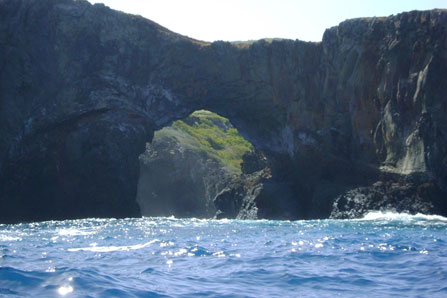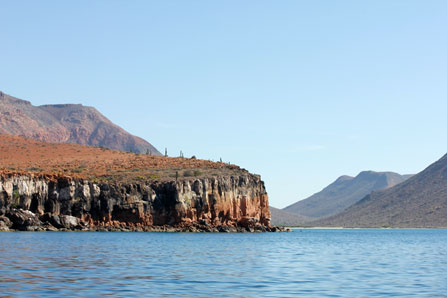Five new natural protected areas established in the Gulf of California
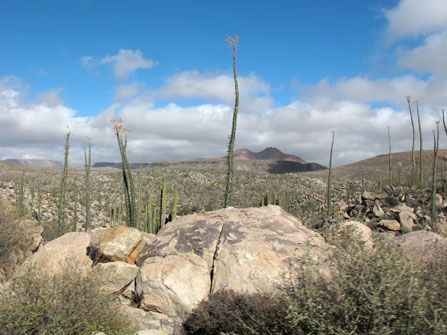
The Valle de los Cirios Protected Area for Flora and Fauna in Baja California is among the five newly designated protected natural areas. (Photo: Debra Valov).
GULF OF CALIFORNIA
The National Commission on Natural Protected Areas (Conanp), an agency of the Ministry of the Environment and Natural Resources (Semarnat), announced on June 8, 2016 in the Official Federal Register that five regions of the Gulf of California were to be incorporated into the National System of Natural Protected Areas (SINAP) because of their biodiversity, the presence of endangered species, the functional integrity of their ecosystems, and the wide variety of ecosystems present.
The areas are: the Hydrothermal Vents of the Guaymas Basin and East Pacific Rise Sanctuary; Los Cirios Protected Area for Flora and Fauna, in Baja California; the Revillagigedo Archipelago Biosphere Reserve; Espiritu Santo Archipelago National Marine Park in Baja California Sur; and The Nayarit National Wetlands Biosphere Reserve.
There were a total of seventeen new protected protected areas (ANPs) decreed in states across the country, with the other twelve including: The Janos Biosphere Reserve, in Chihuahua; the Protected Area for Marine and Terrestrial Flora and Fauna of the Northern End and Eastern Coastal Fringe of Isla Cozumel, in Quintana Roo; the Northern Río Bravo Natural Monument , in the states of Chihuahua and Coahuila; the Lermer Marshes Protected Area for Flora and Fauna, in Mexico state; and the Sierra Del Abra Tanchipa Biosphere Reserve, in San Luis Potosí.
Also on the list were: The Tacaná Volcano Biosphere Reserve in Chiapas; the Bala'an K'aax Protected Area for Flora and Fauna, in Quintana Roo; the Lobos-Tuxpan Reef System Protected Area for Flora and Fauna, in Veracruz; Zicuirán Infiernillo Biosphere Reserve, in Michoacán; the Protected Areas for Natural Resources within the Basins of the Valle de Bravo, Malacatepec, Tolstoc and Temascaltepec Rivers, in Mexico state; Laguna de Términos Protected Area for Flora and Fauna, in Campeche; and the section of the Sierra Gorda Biosphere Reserve within the state of Guanajuato.
In a press release, Conanp explained that per rules outlined in the General Law of Ecological Equilibrium and Protection of the Environment, ANPs should include at least some of the following characteristics:
- richness of species
- presence of endemic species
- species with restricted ranges
- threatened or endangered species
- species different than those included in other ANPs previously incorporated into SINAP
- diversity of ecosystems
- presence of relict ecosystems
- presence of important or fragile natural phenomena
- functionally intact ecosystems
- ecosystems that provide important ecological services
- social viability for its preservation.
Descriptions and characteristics of each of the five new northwest Mexico ANPs, according to Conanp, are as follows:
Hydrothermal Vents of the Guaymas Basin and the East Pacific Rise Sanctuary
This is a marine area that covers approximately 359,700 acres of the Gulf of California and the northern Pacific (where the latter territory comprises the benthic zone between 500 m below sea level and the sea floor). See map (pdf).
This ANP was considered for inclusion because of its specialized habitat and for being a unique seafloor ecosystem along the abyssal plain with hydrothermal vents that are associated with biological oases. Emblematic species include the giant vent or tube worm (Rifita pachyptila), the hydrothermal vent clam (Calyptogena pacifica), the eelpout or ventfish (Thermarces cerberus ), and the brotula (Diplacanthopoma sp.).
The zone’s marine denizens are not threatened, but the new ANP includes important feeding and breeding grounds for many species, including lithodid crabs and eelpouts (Zoarces sp.), as well as habitat for tubeworms and bivalves. The primary ecosystem services provided are: the sequestration of carbon through carbonate (limestone) chimneys; and the preservation of benthic zone mega mega diversity.
Valle De Los Cirios Protected Area for Flora and Fauna
Conanp states the following as reasons for declaring this an ANP: to protect the area's flora and fauna; to allow for the reproduction and population increases in the resident species; to carry out projects that help to establish, protect, and restore soils; to aid in reforestation; and to maintain the ANP’s established environmental framework. See map (pdf).
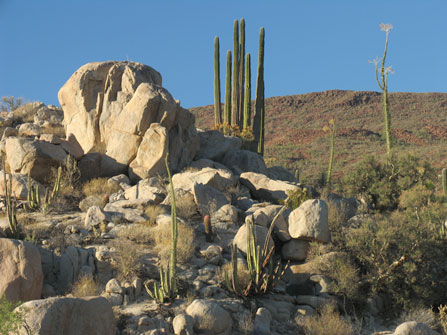
Valle de Los Cirios's desert scrub includes species emblematic to the peninsula such as the Boojum (cirio) and Elephant Cactus (cardón). (Photo: Debra Valov).
This is an ANP with the greatest terrestrial area in Mexico (6.23 million acres) and the second largest in total area. It represents more than 10% of the nation's overall protected territory. Located in the Sonoran Desert, its continuity and integrity form a network of landscapes that are the most extensive in the North American deserts. See Map.
Endangered species include the organillo de Jaraguay (Echinocereus lindsayi), and arrow grass (Triglochin concinnum). The ANP forms part of the Pacific flyway and is used by some neotropical migratory birds as they move from wintering to nesting grounds. Ecological services include: climate regulation, conservation of hydrologic cycles, nitrogen fixation, and soil formation.
Revillagigedo Archipelago Biosphere Reserve
This is a Ramsar Site, protected at the international level, that is rich in terrestrial and marine flora and fauna of high biological value, some of which is unique in the world. At the same time it is a natural laboratory for scientists because of the insular characteristics and the geologic processes to which its communities and ecosystems are subjected.
Much of the reserve’s importance stems from it being the reservoir of a large percentage of the genetic material of the fish populations (many of them commercial varieties) in the Eastern Pacific. Threatened or endangered species include the Bald Eagle (Haliaeetus leucocephalus), Olive Ridley sea turtle (Lepidochelys olivacea), red mangrove (Rhizophora mangle), and white mangrove (Laguncularia racemosa). Finally, according to Conanp, the study of its geologic, oceanographic, and ecological processes will be of great value to developing a better understanding of island systems. See map (pdf).
Natural resources present at this site include the tuna, shark, and lobster (on Isla Socorro) fisheries, as well as minerals (polymetallic or manganese nodules).
Espiritu Santo Archipelago National Marine Park
Conanp states that this represents the largest body of water within the confines of the Gulf of California, conferring on it unique oceanographic conditions for the concentration photosynthetic pigments. Its importance also rests on the great diversity of fish, mammals, marine birds and invertebrates, as well as a great heterogeneity of habitats, all of great ecological integrity, that include mangroves, sandy bottoms, rocky reefs, estuaries, beaches, bays and rodolith beds. See map (pdf).
According to Conanp, what distinguishes this ANP from all others are its natural treasures, including perfectly preserved rocky reefs and 38 unique species of plants and animals, including a colony of sea lions.
Threatened or endangered species are the red, white, and black mangroves (Rhizophora mangle, Avicennia germinans, and Laguncularia racemosa). The importance of these mangrove forests lies in their being a feeding ground, hatchery, and refuge for many different aquatic species, as well as a stopping point on the migratory route of the hammerhead shark and five species of turtles.
Within the Marine Park, mangroves provide habitat for and refuge to both resident and migratory species. They provide feeding grounds and rookery sites for diverse species of terrestrial and marine birds. They also serve to absorb the tidal forces from storms, stabilize coasts, control erosion, fix nitrogen, and sequester carbon. At the same time, they are an important source of food production for human consumption and offer recreational opportunities for both tourists and residents.
Nayarit National Wetlands Biosphere Reserve
This site is protected internationally through the Ramsar Convention on Wetlands and is included in the Western Hemisphere Shorebird Reserve Network as a key bird conservation site. This ANP links 330,760 acres located in the municipalities of Acaponeta, Rasmorada, Santiago Ixcuintla, Tecuala and Tuxpan in the state of Nayarit. See map (pdf).
Information provided by Conanp states that the objectives of having designated this area as an ANP are: to preserve and protect: ecosystems typical of the Nayarit coast which are of national importance; food productivity, important to both humans and migratory birds; and diversity of flora and fauna, including 60 threatened or endangered species.
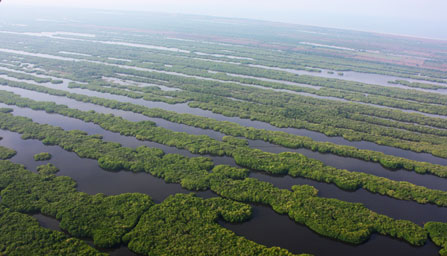
Mangroves in the Nayarit National Wetlands are important for protecting the coastline. (Photo: courtesy of Conanp).
Its uniqueness comes from it being a reservoir for 20% of the nation’s total mangrove forests and a highly productive area for commercial fish species, as well as having wetland areas unique in the country.
A wide variety of ecosystems are found within the reserve, including: lowland tropical forest, intermediate deciduous rain forest, palm forest, halophytic scrub and grasslands, mangroves, coastal dune scrub, xerophytic scrub and introduced vegetation.
Conanp reports eight threatened or endangered species: jaguar (Panthera onca), ocelot, Red knot (Calidrus canutus), mangroves (red, black, white and button-Conocarpus erecta) and oil palms (Orbignya guacuyule).
The National Wetlands reserve is ecologically important because: it provides habitat and nurseries for shrimp and commercial fish species; it provides nesting and feeding grounds for North American migratory birds; and it is a biological corridor for the migration of feline species.
This reserve is also valuable because it helps to: diminish the impacts of hurricanes and reduce beach and coastal erosion; produce oxygen; regulate temperatures and minimize global warming impacts; provide fresh water as well as improve water quality; produce food; help prevent the salinization of agricultural lands; and capture and sequester carbon.
Information in English on the Nayarit National Wetlands Biosphere Reserve is available here.

